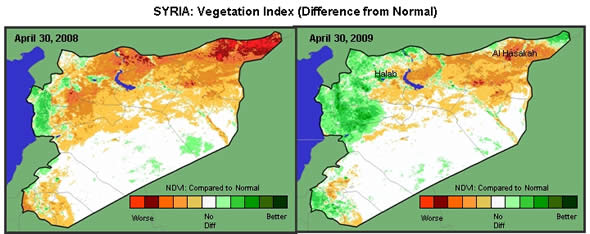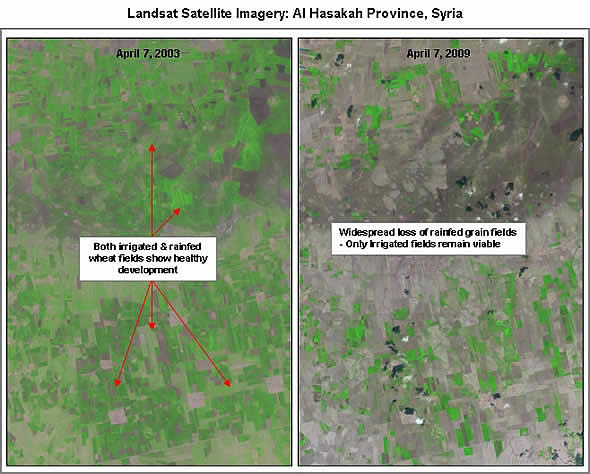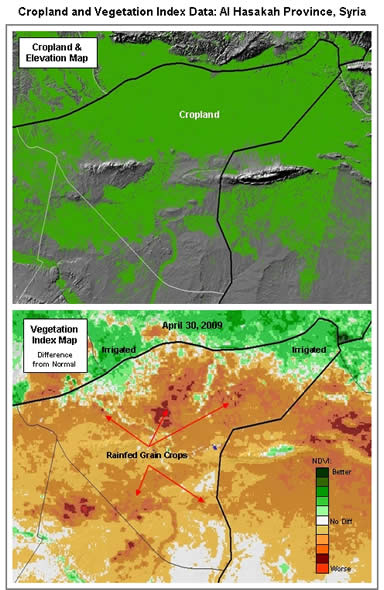SYRIA: Wheat Production Outlook Improved in 2009/10
 Improved seasonal rainfall conditions and increased use of irrigation allowed Syria to increase wheat production compared to last year’s severe drought. Total production, however, is expected to remain well below average. Normal to above normal rainfall in western and northern wheat growing areas helped improve overall grain production prospects this year. In addition, satellite imagery analysis showed that irrigated crops were much more successful, owing to increased water supplies from Turkey or Syrian water use policies targeting increased grain production. However, drought conditions did play a major role in limiting the overall increase in national wheat production this year. Despite regional drought, total wheat production is expected to increase roughly 44 percent over last year, though Syria will harvest the second smallest crop of the past decade. The disappointing 2009/10 wheat harvest could lead to significant additional grain imports in the MY2009/10 marketing year. Syria drew down emergency grain reserves in MY2008/09 because of the drought-devastated crop. Improved seasonal rainfall conditions and increased use of irrigation allowed Syria to increase wheat production compared to last year’s severe drought. Total production, however, is expected to remain well below average. Normal to above normal rainfall in western and northern wheat growing areas helped improve overall grain production prospects this year. In addition, satellite imagery analysis showed that irrigated crops were much more successful, owing to increased water supplies from Turkey or Syrian water use policies targeting increased grain production. However, drought conditions did play a major role in limiting the overall increase in national wheat production this year. Despite regional drought, total wheat production is expected to increase roughly 44 percent over last year, though Syria will harvest the second smallest crop of the past decade. The disappointing 2009/10 wheat harvest could lead to significant additional grain imports in the MY2009/10 marketing year. Syria drew down emergency grain reserves in MY2008/09 because of the drought-devastated crop.

Rainfall conditions have been extremely mixed during the 2009/10 growing season, with the most favorable accumulations occurring in western and northwestern regions. Southern, southeastern and northeastern regions all suffered continuing drought conditions and well-below normal rainfall. The provinces primarily affected by poor rainfall included the top four wheat producers which account for 75 percent of total wheat production in Syria (Al-Hasakah, Ar-Raqqah, Aleppo or Halab, and Dier ez-Zor). Rainfed wheat area in these provinces normally amounts to more than 800,000 hectares, and is extremely reliant on timely rainfall during the growing season. Favorable rainfall in April and May are typically critical to successful growing seasons, and this year non-irrigated crops were already failing in late March. April rainfall was extremely low throughout northern and northeastern wheat regions this year, causing even greater moisture stress and decimating crop yield potential.

Vegetation index maps from the Spot satellite illustrate the significant improvement in crop vegetation this year in northwestern provinces following unusually beneficial winter and spring rainfall. At this time last year severe drought gripped the vast majority of Syria’s grain producing provinces, causing an estimated 48 percent decline in national wheat production. In the current 2009/10 growing season the best rainfall accumulations occurred in minor producing areas, with the bulk of major grain growing areas suffering continued drought. As a result, crop vegetative development in the drought areas is well-below normal. Though the declines in vegetative vigor are not as severe as last year, they indicate that only a modest recovery in wheat production is to be expected. Harvest activities normally begin in June, with crops reaching their maximum biomass in late April. This year, however, the majority of rainfed wheat crops began to wither in late March, some 7-8 weeks early. This is indicative of severe drought stress, resulting in substantial crop yield losses if not total crop failure. Given the mixed crop conditions across Syria USDA estimates 2009/10 wheat production at 3.0 million tons, up 0.9 million or 44 percent from last year but down approximately 30 percent from the 5-year average.

The Landsat satellite images above from Al Hasakah province in northeastern Syria illustrate the very poor growing conditions prevalent in the country’s top wheat producing province in early April 2009. The images compare the current season to 2003 (a good year) when Syria produced nearly 4.8 million tons of wheat. It is apparent in 2009 that much of the cropland is barren owing to a lack of viable rainfed grain crops, and that only irrigated fields are showing near-normal vegetative conditions. Rainfed crop area is expected to be well-below normal levels in the entire north and northeastern growing regions as a result of critically low rainfall during the growing season.
This satellite image evidence is critical to understanding the extremely poor crop development that is evident in large-scale regional vegetation index maps this season. The entire grain growing region in Al Hasakah province is the focus in the two maps below, providing an illustration of the extremely poor current crop vegetation conditions. Based on the vegetation index and satellite image analysis, it is apparent that rainfed crop area has fallen dramatically and that surviving crops have much-below normal vegetative development. This implies that crops are under serious moisture stress and that crop density is sparse. Moisture stress and sparse vegetation indicate low yield potential for the grain crops this season. On the other hand, it is also apparent that irrigated crops are being managed well and that they have above normal vegetative vigor at this stage of the growing season. This implies that irrigated crop yields will likely exceed typical levels, and that increased grain production in these areas will somewhat offset losses in the major rainfed regions. However, rainfed wheat production losses are expected on such a widespread basis that total wheat production will remain below normal levels in 2009/10.

Current USDA area and production estimates for grains and other agricultural commodities are available on IPAD's Agricultural Production page or at PSD Online.
|

